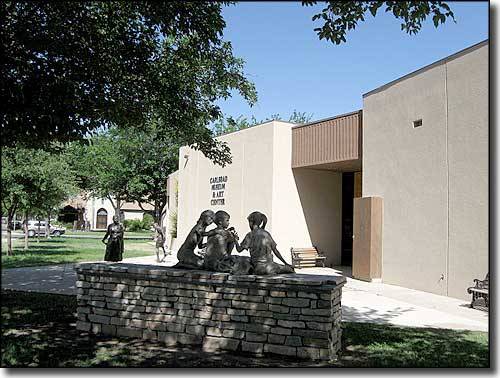
Carlsbad is located in the Pecos River Valley in the Chihuahuan Desert of southeastern New Mexico. Carlsbad Caverns National Park is about 18 miles southwest of town.
Carlsbad began life as the town of Eddy in 1888, founded by the brothers Charles B. and John Eddy. An early local rancher was former sheriff Pat Garrett (of Billy the Kid fame). Garrett, a promoter named Charles Greene and the Eddy brothers worked together and built a system of canals and flumes to divert irrigation water to their properties. Greene found an East Coast investor named Robert Tansill to fund the project, the money to be returned through the selling of lots in the town of Eddy. By 1889, Eddy's first school opened with 35 pupils. The first train arrived in Eddy in 1891, coming from Pecos, Texas.
Eddy was incorporated in 1893 but after development of the local mineral springs, the name was changed to Carlsbad in 1899, in emulation of a famous mineral spa in what is now the Czech Republic (originally Carlsbad, Bohemia but now known as Karlovy Vary). The healing properties in the water and the mineral content of the two springs, half a world apart, is almost identical.
The vast majority of Carlsbad's early development was based on irrigation water. One project involved the construction of the Avalon Dam and the many canals the impounded water was to feed into. Water was supplied to the irrigation system by a wooden flume that carried water from Lake Avalon downstream to Carlsbad. At one point, this flume crosses over the Pecos, giving rise to a "Believe It or Not" notation: the river that crosses over itself. A flood in 1902 destroyed that original wooden flume but it was rebuilt as a concrete aqueduct and is still in use to this day.
Local cowboys discovered Carlsbad Caverns in 1901 and as the fame of that site grew, protectionists clamored for help from the federal government. The National Park was designated on May 14, 1930 as a result of that. Potash was discovered near Carlsbad in 1925 and for many years, potash from this area dominated the fertilizer markets. However, as usual with these things, the potash market started dropping off in the 1960's and the economy of Carlsbad started dropping off with it.
Then the US Government started looking for a long-term repository for low level nuclear waste, a waste product that had been building up at the nation's nuclear power generating plants for years. One major think tank suggested storing the waste in a salt mine and another think tank suggested a salt mine east of Carlsbad. That was the birth of the Waste Isolation Pilot Plant (WIPP). The WIPP project was authorized by Congress in 1979 and construction began in 1980. Because these nuclear waste products have half-lives running into the tens of thousands of years, long term safety issues were of critical importance. Also, as all of the waste products needed to be transported to the site from hundreds of miles away, construction for the program entailed elements like construction of a bypass around the north and west sides of Santa Fe (to bring waste out of Los Alamos without carrying it through the city streets), development of the TruPac container (specifically for isolating and transporting nuclear materials and then holding them intact for 10,000 years or more once buried), development of trucks for carrying TruPac containers and designation of the routes used by these trucks to carry nuclear waste from sites all across the western states to the WIPP site east of Carlsbad. As part of the project each TruPac container contains a "beeper" so that each container can be tracked by satellite as it moves across the countryside (to prevent the loss of those low-level radiation/nuclear materials). All of the logistics are centralized at the DOE office that opened in Carlsbad in 1993. After years of working on this project, the first waste shipment arrived and was buried several thousand feet underground in the salt mine in 1999. Trucks have been arriving daily with more nuclear waste materials since then. Sandia and Los Alamos National Laboratories have also opened branch operations in Carlsbad.
The countryside around Carlsbad overlies rich natural gas and oil deposits deep in the Permian Basin formations. With the push to develop more domestic sources of natural gas and oil, the economy of Carlsbad has been rising with the influx of workers and business devoted to the drilling and production of these resources.
One of the branch campuses of New Mexico State University is located in Carlsbad.

Carlsbad Public Library

